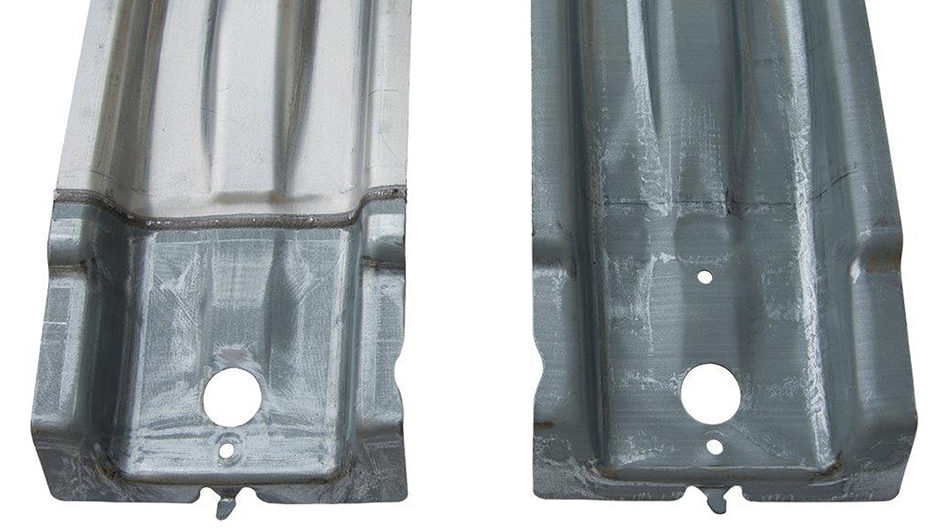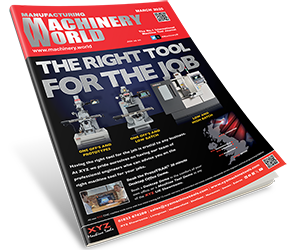The thermal joining of different materials such as steel and aluminium is of crucial importance in automotive lightweight construction. However, this process is particularly challenging due to the different physical and chemical properties of the materials. It is difficult to achieve high-quality, stable results and the options for further working of the semi-finished parts are significantly restricted. The solution to these challenges is a welding process with reduced heat input – the Cold Metal Transfer (CMT) process developed by Fronius. The low level of spattering coupled with the constant and extremely stable arc deliver optimum welding results. International automotive industry supplier Magna Steyr has taken CMT and developed a technology that not only makes it possible to manufacture bodywork parts much more cost-effectively, but also allows weight savings to be achieved too.
Car body manufacturers in the automotive industry are increasingly relying on a combination of different materials – and with good reason. The weight of the vehicles can be reduced considerably by using materials such as aluminium or fibre-reinforced plastics, which has a positive effect on performance and fuel consumption. It would also be hard to meet the ever more stringent exhaust emission regulations without these advances in lightweight construction. Modern vehicles therefore tend to have an ingenious mix of materials, right down to the finest details – every individual part is designed to be as light as possible yet still provide optimum functionality. However, joining these materials, with their very different properties, poses a huge challenge.
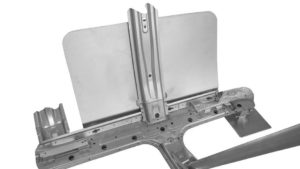
Additional, expensive joining processes such as punch riveting become a thing of the past using CMT welding – leading to greater cost-effectiveness.
Restricted strength and formability
Steel and aluminium is one of the most frequent combinations of materials to be joined in automotive lightweight construction. To reduce costs, manufacturers weld flange components made of aluminium to galvanised steel plates, so that they can be joined using the conventional, cost-effective spot welding process on the bodyshell production line. However, the different physical and chemical characteristics of these two materials, such as their thermal elongation, heat conduction and corrosion resistance, must be taken into account. These have a negative effect on the quality and strength of the welded joint. The formability in subsequent production processes is also very limited.
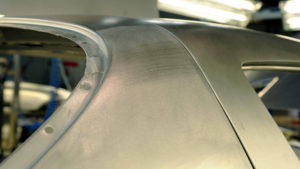
Car body manufacturers in the automotive industry are increasingly relying on a combination of different materials.
The reason for this restricted formability lies in what is known as the intermetallic phase, which forms where the two materials touch and fuse together when they are welded. This layer is brittle and susceptible to cracks and pores, which impairs the stability of the joint. International automotive industry supplier Magna Steyr was keen to address this problem. The company, which is headquartered in Graz, Austria, develops and produces individual components and complete vehicles, and uses lightweight construction methods for its vehicle bodies. In order to lower the production costs for steel-aluminium weldments, Magna Steyr examined the joining process in great detail and came to the conclusion that the temperature has a critical influence on the weld seam quality.
A “cold” welding process improves the stability
The heat input during welding plays a significant role in determining the thickness of the intermetallic phase. In the trials carried out by engineers, Magna Steyr discovered that ideally this should not exceed ten micrometres to ensure the joint is stable. To achieve this, the experts had to control the temperature progression in an optimal manner, keeping it above the melting temperature of aluminium but below the vaporisation temperature of the zinc layer applied to the steel plates. In most arc-welding processes, this is simply not possible, but Magna Steyr finally found the solution they needed in Cold Metal Transfer (CMT), the “cold” welding process developed by Fronius.
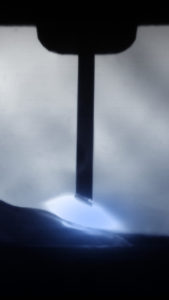
In the CMT welding process, the arcing phase is kept very short and the heat input reduced. Using this process, the energy input can also be continuously adapted to suit the component to be welded.
The CMT welding process significantly reduces the heat input in comparison to other MIG/MAG processes. The secret lies in the digital process control, which automatically detects short circuits and then helps to detach the droplet by retracting the wire: during welding, the wire moves forward and is pulled back again as soon as the short circuit occurs. As a result, the arcing phase is very short and the heat input reduced. Using this process, the energy input can also be continuously adapted to suit the component to be welded. Users benefit from spatter-free material transfer and optimum welding results. CMT is therefore ideal for welding steel joints using CO2 and other shielding gases. It is also intended for use in the joining of steel and aluminium, as the steel base material is only wetted by these braze-welded joints and does not melt. This means it perfectly meets the requirements for use in the automotive industry.
Outstanding results from an exceptional process
With the help of the CMT welding process and by optimising the welding wire, Magna Steyr has developed a technology for joining steel and aluminium efficiently and reliably. Being able to set the welding parameters precisely keeps the intermetallic phase thinner than ten micrometres. The mechanical properties of the joint meet all the requirements placed on them. Compared to conventional processes, CMT also offers the advantage that welding no longer needs to be carried out on both sides, but now only on one side, which lowers costs and reduces the workload. Additional, expensive joining processes such as punch riveting also become a thing of the past – leading to even greater cost-effectiveness.
Magna Steyr won the 2017 AutomotiveINNOVATIONS Award from the Center of Automotive Management (CAM) and PricewaterhouseCoopers (PwC) Germany for its innovative joining technology. Magna was recognized as the Most Innovative Automotive Supplier by impressing the jury in the chassis, car body and exterior category.
Fronius UK Ltd
+44 1908 512300


